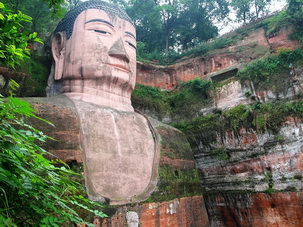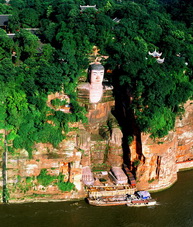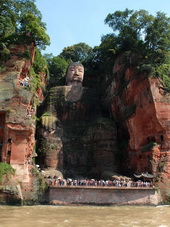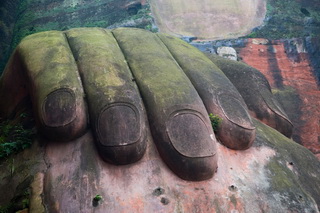 About 160 km south of Chengdu, the 71m-high Leshan Giant Buddha sits in a cliff overlooking the confluence of Minjiang, Dadu and Qingyi River. A local saying goes: "The mountain is a Buddha, and the Buddha is a mountain". Legend has it that an eminent monk Hai Tong of the Tang Dynasty (618-907) often saw boats capsize in the turbulent river. Shipwrecks were a common place. Wishing to protect passing boats and calm down the rough river currents, the monk vowed to build a Maitreya Buddha. He made great efforts to collect the funds for the construction.
About 160 km south of Chengdu, the 71m-high Leshan Giant Buddha sits in a cliff overlooking the confluence of Minjiang, Dadu and Qingyi River. A local saying goes: "The mountain is a Buddha, and the Buddha is a mountain". Legend has it that an eminent monk Hai Tong of the Tang Dynasty (618-907) often saw boats capsize in the turbulent river. Shipwrecks were a common place. Wishing to protect passing boats and calm down the rough river currents, the monk vowed to build a Maitreya Buddha. He made great efforts to collect the funds for the construction. The Giant Buddha of Leshan (aka Dafo) is the tallest stone Buddha statue in the world. The Giant Buddha statue depicts a seated Maitreya Buddha with his hands resting on his knees, gazing across the river with heavy-lidded eyes. Maitreya is the future Buddha, who will appear to preach the dharma when the teachings of Gautama Buddha have faded away. He was especially popular during the 4th to 7th centuries and his images can be found throughout the Buddhist world, conveying his characteristic air of expectancy and promise.
The Giant Buddha of Leshan (aka Dafo) is the tallest stone Buddha statue in the world. The Giant Buddha statue depicts a seated Maitreya Buddha with his hands resting on his knees, gazing across the river with heavy-lidded eyes. Maitreya is the future Buddha, who will appear to preach the dharma when the teachings of Gautama Buddha have faded away. He was especially popular during the 4th to 7th centuries and his images can be found throughout the Buddhist world, conveying his characteristic air of expectancy and promise.
Several drainage passages hidden in the Buddha's hair, collar, chest, and holes in the back of his ears preventing the Buddha from serious erosion and weathering. He has been lovingly maintained on a regular basis throughout his 1,200-year history, but is still a bit mossy.
back of his ears preventing the Buddha from serious erosion and weathering. He has been lovingly maintained on a regular basis throughout his 1,200-year history, but is still a bit mossy.
 Visitors stare in awe at the Buddha from the tourist ferries and from a terrace next to his ear. On one side of the terrace is a modern statue of the monk Haitong, and behind is the Lingyun Temple Museum with exhibits on the construction and renovations of Dafo. South of the Giant Buddha is Wuyou Si, which visitors pass on the way from the ferry to the Buddha. A pink-walled monastery founded in 742 AD, it has impressive decorations including splendid gate guardians, painted scenes from the Journey to the West (on the second hall) and amusing sculptures of arhats (inside the Louhan Hall).
Visitors stare in awe at the Buddha from the tourist ferries and from a terrace next to his ear. On one side of the terrace is a modern statue of the monk Haitong, and behind is the Lingyun Temple Museum with exhibits on the construction and renovations of Dafo. South of the Giant Buddha is Wuyou Si, which visitors pass on the way from the ferry to the Buddha. A pink-walled monastery founded in 742 AD, it has impressive decorations including splendid gate guardians, painted scenes from the Journey to the West (on the second hall) and amusing sculptures of arhats (inside the Louhan Hall).
On the other side of the gully on Lingyun Shan, there are signs for Han-dynasty tomb chambers, which suggest this site was sacred before the Buddha was carved.

 China Tours
China Tours Tibet Tours
Tibet Tours China Theme Tours
China Theme Tours Off The Beaten Track
Off The Beaten Track Yangtze Cruises
Yangtze Cruises China Trip Planner
China Trip Planner Travel Agents
Travel Agents China Tours
China Tours Tibet Tours
Tibet Tours China Theme Tours
China Theme Tours Off The Beaten Track
Off The Beaten Track Yangtze Cruises
Yangtze Cruises China Trip Planner
China Trip Planner Travel Agents
Travel Agents


 0086-28-85711328
0086-28-85711328 0086-28-85546015
0086-28-85546015





 About 160 km south of Chengdu, the 71m-high Leshan Giant Buddha sits in a cliff overlooking the confluence of Minjiang, Dadu and Qingyi River. A local saying goes: "The mountain is a Buddha, and the Buddha is a mountain". Legend has it that an eminent monk Hai Tong of the Tang Dynasty (618-907) often saw boats capsize in the turbulent river. Shipwrecks were a common place. Wishing to protect passing boats and calm down the rough river currents, the monk vowed to build a Maitreya Buddha. He made great efforts to collect the funds for the construction.
About 160 km south of Chengdu, the 71m-high Leshan Giant Buddha sits in a cliff overlooking the confluence of Minjiang, Dadu and Qingyi River. A local saying goes: "The mountain is a Buddha, and the Buddha is a mountain". Legend has it that an eminent monk Hai Tong of the Tang Dynasty (618-907) often saw boats capsize in the turbulent river. Shipwrecks were a common place. Wishing to protect passing boats and calm down the rough river currents, the monk vowed to build a Maitreya Buddha. He made great efforts to collect the funds for the construction. The Giant Buddha of Leshan (aka Dafo) is the tallest stone Buddha statue in the world. The Giant Buddha statue depicts a seated Maitreya Buddha with his hands resting on his knees, gazing across the river with heavy-lidded eyes. Maitreya is the future Buddha, who will appear to preach the dharma when the teachings of Gautama Buddha have faded away. He was especially popular during the 4th to 7th centuries and his images can be found throughout the Buddhist world, conveying his characteristic air of expectancy and promise.
The Giant Buddha of Leshan (aka Dafo) is the tallest stone Buddha statue in the world. The Giant Buddha statue depicts a seated Maitreya Buddha with his hands resting on his knees, gazing across the river with heavy-lidded eyes. Maitreya is the future Buddha, who will appear to preach the dharma when the teachings of Gautama Buddha have faded away. He was especially popular during the 4th to 7th centuries and his images can be found throughout the Buddhist world, conveying his characteristic air of expectancy and promise.  back of his ears preventing the Buddha from serious erosion and weathering. He has been lovingly maintained on a regular basis throughout his 1,200-year history, but is still a bit mossy.
back of his ears preventing the Buddha from serious erosion and weathering. He has been lovingly maintained on a regular basis throughout his 1,200-year history, but is still a bit mossy.  Visitors stare in awe at the Buddha from the tourist ferries and from a terrace next to his ear. On one side of the terrace is a modern statue of the monk Haitong, and behind is the Lingyun Temple Museum with exhibits on the construction and renovations of Dafo. South of the Giant Buddha is Wuyou Si, which visitors pass on the way from the ferry to the Buddha. A pink-walled monastery founded in 742 AD, it has impressive decorations including splendid gate guardians, painted scenes from the Journey to the West (on the second hall) and amusing sculptures of arhats (inside the Louhan Hall).
Visitors stare in awe at the Buddha from the tourist ferries and from a terrace next to his ear. On one side of the terrace is a modern statue of the monk Haitong, and behind is the Lingyun Temple Museum with exhibits on the construction and renovations of Dafo. South of the Giant Buddha is Wuyou Si, which visitors pass on the way from the ferry to the Buddha. A pink-walled monastery founded in 742 AD, it has impressive decorations including splendid gate guardians, painted scenes from the Journey to the West (on the second hall) and amusing sculptures of arhats (inside the Louhan Hall).